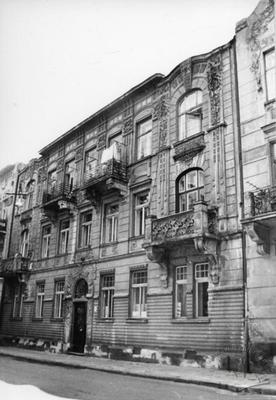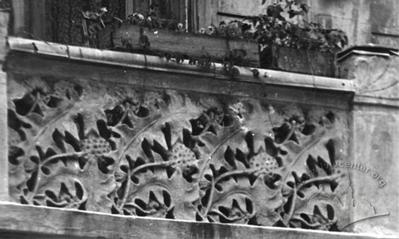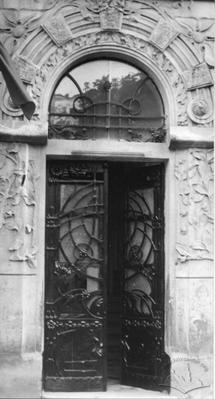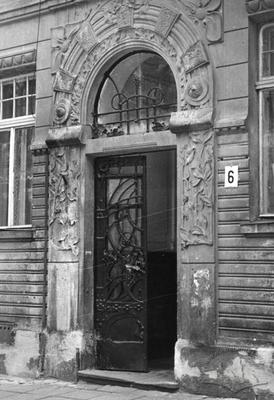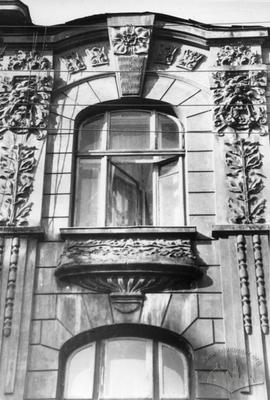Vul. Bohomoltsia, 06 – Center for Urban History of East Central Europe building
A three-storied building was constructed in 1906 under a project developed at the bureau of Ivan Levynskyi (Jan Lewiński) as an apartment house belonging to Leon Stauber, an entrepreneur. The principal façade was designed by architect Tadeusz Obmiński. This ornamental Secession style building is one of the best examples of this style in Lviv and has been listed as an architectural monument (protection number 6). Today, much of it is occupied by the Center for Urban History of East Central Europe.
Architecture
The house is located in the row housing of Bohomoltsia street. This is a former residential townhouse, typical of the 1900s, when houses were designed already connected to the water supply and sewerage systems, as well as to electricity. The nature of the house’s planning was modern as all kitchens and bathrooms were located inside the apartments and not at the wing’s edges, accessible through galleries, as it used to be earlier. In addition, these utility rooms occupy the worst places (in terms of natural lighting). The house's decorative design belongs to the ornamental Secession style, with stylized elements of classical architecture.
The house has three floors, basements and a small attic facing the courtyard. It is built of brick and plastered. The basements are covered with the so-called Klein’s system vault (small brick segment vaults supported by metal beams)while the ceilings between the floors are made of metal I-beams. The framed roof structure is wooden. The roof itself is made of tin and painted dark red. Stucco, majolica tiles, forged metal is used in the façade décor. The staircase has stained glass windows; interior doors and windows have brass fittings; there used to be also a brass railing in the entryway earlier.
The building is U-shaped in plan with a rectangular front building and two wings, as well as a closed courtyard in the middle. According to the original design, two five-room apartments were located on each floor. In each apartment, there were two rooms with windows facing the street and three rooms located in the wing. Kitchens, toilets, and bathrooms as well as cells and niches for servants were placed in the front building. Near one of the apartments, there were winding backstairs leading up to the gallery and then to kitchens or to the laundry and ironing room located in the attic.
The main façade is symmetrical. Its compositional pattern is more typical of historicism: strict symmetry, the façade’s division with stylized "giant" order having a pedestal, pilasters, and entablature. The richest décor can be seen on the main portal and on the side parts of the façade crowned with small attics. Rich décor in the ornamental Secession style is added to this pattern: stylized leaves and flowers around the portal, second floor balconies railing with stylized dandelions, insertions with moulded leaves under the windows and on the stylized capitals of the pilasters.
In 1930 the ground floor apartments were rearranged; as a result, two two-room apartments were formed, one in the front building and the other in the wing. With this in view, some partitions were reconstructed, a door was made in the bearing wall, one of the windows in the wing was expanded and divided into two parts.
Since 2004 the building has been occupied by the Center for Urban History. As it had to be adapted for offices, some reconstruction works were conducted.
Related Places
Vul. Bohomoltsia, 09 – Lviv Oblast Prosecutor Office (former residence)
Show full description
Personalities
-
Ivan Levynskyi
–
One of the most renowned architects of Habsburg Lviv, entrepreneur, one of the largest employers of his time in the city. His firm was involved in the construction and renovation of countless structures throughout Lviv and the region. Professor at the Higher Technical School, an active public figure associated with the Ukrainian People's Movement.
-
Andrij Bojarov
–
Media artist, researcher of Lviv and Ukrainian avant-garde, independent curator, architect. For the most part, he lives and works between Ukraine, Poland and Estonia.
-
Yevhen Ravskyi
–
A painter, action artist, and the longstanding curator of the Lialka cultural center in Lviv. Lives and works in Lviv.
Blasbałg, Józef – a resident of the house in 1937.
Dmorowski, Bolesław –
an engineer (specializing in electrical lamps), a resident of the house in 1914.
Dmorowski, Władysław – a law student, an engineer, a resident of the house in 1913-1914.
Goldberg, Irena –
a co-owner of the house.
Gottfried, Karol – the Petrolea bureau director, a resident
of the house in 1910.
Griffel, Klara – a private tutor, a resident of the house in 1913.
Griffel, Maurycy –
an engineer, a resident of the house in 1913.
Lachowska, Bożena – a retired woman,
a resident of the house in 1914.
Obmiński, Tadeusz – an architect
of Jan Lewiński’s bureau who designed the project of the house’s front façade.
Paszkowski, Mieczysław –
a doctor, the «Spilchansky» (Union) bank director, a resident of the house
in 1913.
Pogonowska M. – a doctor who
treated skin and venereal diseases,
a resident of the house in 1932.
Pogonowska, Helena –
a notary’s widow, a resident of the house in 1914.
Rodkin A. Z. – a resident
of the house in 1940.
Sawicki, Leszek –
a Polish scientist, co-founder of the Society of Lviv Lovers in Wroclaw.
Smoliński, Jan –
a constructor who managed the reconstruction works.
Sosin,
I. I. – a resident of
the house in 1940.
Stauber Ch. – a resident of
the house in 1932 who owned a café for women (pol. konfekcja damska) on Halytska
(then Halicka) street, 17.
Stauber, Leon – a merchant and enterpreneur who owned
the house and real
estate and on Halytska (Halicka) street 17.
Stauber-Bryndzowa, Dora – a co-owner of
the house and real
estate.
Szelewicz, Lew –
an architect, a resident of the house in 1914.
Teodorowicz, Kazimierz –
an architect of Jan Lewiński’s bureau who performed the calculation
of the house constructions.
Tomiński, Marjan –
the house manager who lived on Żyrzyńska street 17.
Wajda, Władysław –
an employee, a resident of the house in 1910
Witosławska, Klementyna (née Bochdan) – the owner of the old plot.
Interview
Sources
- State Archives of Lviv Oblast (DALO) 2/1/126.
- Informator lwowski, 1932.
- Ksiega adresowa krolewskiego stolecznego miasta Lwowa (Lemberg, 1914).
- Lewicki Jakub, Między tradycją a nowoczesnością: Architektura Lwowa lat 1893–1918 (Warsaw: Towarzystwo Opieki nad Zabytkami, Wydawnictwo Neriton, 2005), 258-261.
- Skorowidz krolewskiego stolecznego miasta Lwowa (Lemberg, 1910).
- Skorowidz krolewskiego stolecznego miasta Lwowa (Lwow, 1920).
- Spis abonentow sieci telefonicznej..., 1937.
- Жук Ігор, "Львівська пам’ятка стилю модерн. Ансамбль вулиці Богомольця та його архітектор", Жовтень, 1983, №12, 83-85.
Media Archive Materials
Related Pictures

































